Introduction
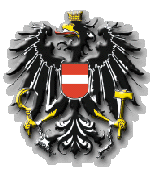 Destroyers in Austro-Hungary were a logical development of sea-going torpedo-boats, like in other navies. This lineage went to three stages, the third one being the result of war lessons and confined to the drawing board and then archives of the successors states. Speaking of Torpedo Boats, the old empire started early enough, following the development of the torpedo, first created by a Croatian officer (Ioann Lupis) and later reworked by a British engineer (John Thornycroft). Thes first destroyers, as called, were merely prototypes with an emphasis on artillery, mostly quick-firing guns. The most popular was the 47mm revolver Hotchkiss, but 6.6 cm.
Destroyers in Austro-Hungary were a logical development of sea-going torpedo-boats, like in other navies. This lineage went to three stages, the third one being the result of war lessons and confined to the drawing board and then archives of the successors states. Speaking of Torpedo Boats, the old empire started early enough, following the development of the torpedo, first created by a Croatian officer (Ioann Lupis) and later reworked by a British engineer (John Thornycroft). Thes first destroyers, as called, were merely prototypes with an emphasis on artillery, mostly quick-firing guns. The most popular was the 47mm revolver Hotchkiss, but 6.6 cm.
Torpedo Ships
There was in fact a whole range of torpedo ships at large, the light cruisers of the Panther class and Tiger were essentially torpedo cruisers, and the Zara class were elegant barquentines, almost yachts in disguise, dating back to 1879 and less than 1000 tons. On the other hands classic TBs comprised British, German-built boats spread into first and second class. The latter comprised only 1880s B, C and D classes, and First class the Tb19-Tb40. Ships from the late 1870s has been in general scrapped or retired well before 1914. There was also a group of 6 high-seas TBs of the Viper, Natter and Python class, 124-166 tons ships dating back from 1895-99 still in service during WW1. Series of high seas torpedo boats went on through the Kaiman, Tb74T, Tb82F and Tb98M. Read more about ww1 Austro-Hungarian TBs.
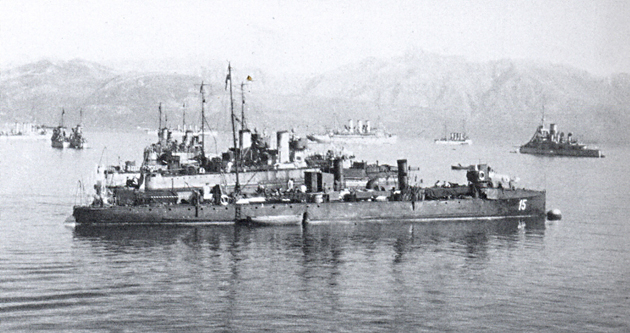
SMS Meteor (1887)
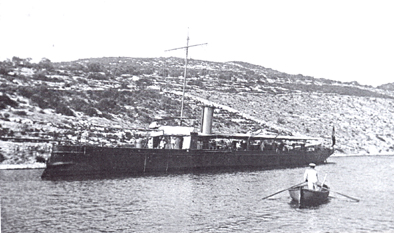
The first Austro-Hungarian destroyer looked more like a torpedo boat than a proper destroyer. She was built by order of November 20, 1886, with a contract concluded in December in Schichau-Werke, Elbing at Baunummer 342, 380/381 in Germany. On March 12, 1887, Francis Joseph Emperor Emperor approved the name and the ship arrived as completed on June 15. She started trials in August, achieving 23.1 knots, well above the shipyard’s claim, making doubts about measuring instruments. She was finally accepted into service in August 31, and on October 1894, rescued four members of the Italian ship Marco Polo in a heavy sea. This was 26 miles southwest of Mezzó. Her captain was awarded as well as the crew.
She later suffered a boiler accident and in 1900 whe was in drydock with her boiler repaired. From 1902, she joined the Naval Academy. In 1903, she went on in summer practice sessions and in 1905, the mast was lowered and a torpedo-scaffold mounted on the deck. Between 29 April and 22 August, she carried out geographical surveys along the Dalmatian coast and in 1910, had new boilers and a modernized engine, but went into reserve. She was used in training in 1914 and next year was transferred to Pola as a patrol boat and harbour defence ship. In 1916 she patrolled and escorted the area in front of the harbour, and later rescued the crew of a damaged airplane and went on making other escorts with 41 convoys and 2 submarines. In 1920 she was sold for scrap to an Italian yard.
SMS Meteor Specifications
Displacement: 358–360 t, maximal 422 t
Dimensions: 58,73 m pp 60,68 m oa, x7,4 m x2,35 m
crew: 61
Powerplant: 2 loco boilers, TE engne 2860 -3500 ihp, 1 screw
Top speed 17.5 knots (23 on trials)
Armament 9× 47-mm-Hotchkiss QF guns, 1× 35cm spar torpedo, later 2x 450mm TTs
Blitz class destroyers (1888)
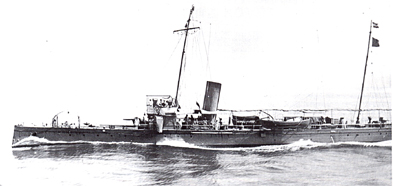
SMS Blitz
About the same era and built (Schichau, Elbing), SMS Blitz and Komet made the only “class” of destroyers in the first serie of ships of this classification. The landing of Greek troops in Crete in February 1897 during the Turkish-Greek War saw the k.u.k. Kriegsmarine intervene with other powers, and both destroyers were part of the 20 ships showing the flag off Crete. This Austrian force was the third largest fleet dispatched after the Royal Navy and Regia Marina. SMS Blitz remained in Crete until the beginning of December 1897. SMS Komet relieved her at the beginning of April.
The Blitz remained in service after the Crete operation and conducted radio tests in 1900 and 1901. In 1902 she was in drydock until 1903 with the removal of her 47-mm rear gun and receiving in place an additional rotatable 35-inch torpedo tube, like the Russian Kasarsky class then in completion. She went into reserve afterwards. In the short term she remained as a school ship for the Naval Academy, from 1906 to 1908. In August 1909 she sailed to Sebenico to serve as Archduchess Maria Josepha’s yacht. She was then regularly used for coastal defense exercises and to monitor the Albanian coast, partially deactivated in January 1914 in Pola.
On her side, SMS Komet was temporarily placed into reserve, but served from 1904 as a schoolship for the Naval Academy also receiving an additional rotatable torpedo tube at the rear. From 1911, she was part of the torpedo boat flotilla but was once more deactivated on 22 February 1913. She will also receive new boilers and a second funnel. On March the comet returned into service, as guardship in Sebenico and for Coast Guard duties in the coastal area. When she resumed her new trials, she reached a top speed of 17.31 knots and was sent to patrol the Albanian coast and remained in this area until the end of March 1914.
SMS Blitz Specifications
Displacement: 425 t FL
Dimensions: 58.4 x 7.4 x 3.2m
crew: 60
Powerplant: 2 loco boilers, TE engine 2360 ihp, 1 screw, Top speed 21 knots
Armament 8x 47-mm-Hotchkiss QF guns, 2x 450mm TTs
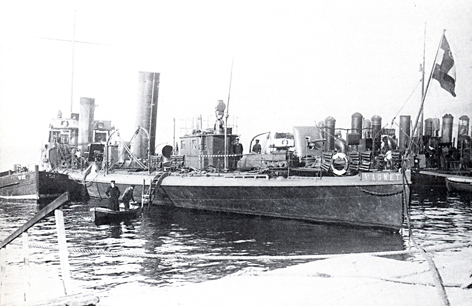
SMS Magnet, rear view
Early destroyers Planet, Trabant, Satellit, Magnet (1889-1896)
We can hardy speak of a class there. This is a group only for simplification as none of them were standardized or came from the same builder. So here we go:
-SMS Planet: Built at Palmer Newcastle (UK) in 1889. 525 tonnes, 64 x 7.1 x 2.8m, 3000 hp, 19 knots, 2x 400mm TTs, 2×70 mm, 8x 47mm QF guns, crew 84.
-SMS Trabant: Built locally at STT in 1890. 540 tonnes, 67.2 x 8.2 x 2.5m, 3500 hp, 20.4 knots, 2x 450mm TTs, same as above, crew 84.
-SMS Satellit: Built at Schichau, Elbing in 1892. 616 tonnes, 68.9 x 8.1 x 2.7m, 4500 hp, 21.9 knots, 2x 450 mm TTs, 1x 70mm, 8 x47mm QF, crew 80.
-SMS Magnet: Built at Schichau, Elbing in 1896. 544 tonnes, 67 x 8.2 x 3.3m, 5652 hp, 24 knots, 2x 450mm TTs, 6x 47mm QF guns, crew 80.
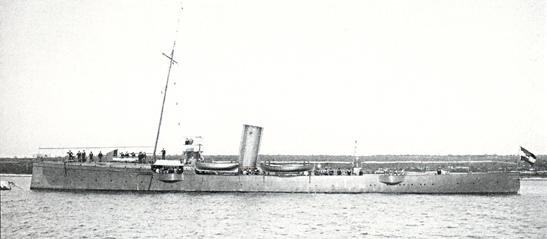
SMS Satellit
The SMS Planet was adapted as a minesweeper in 1915, just like the Trabant, and both were offered to italy after the war and scrapped. SMS Satellite in 1912-1913 was refitted with new Yarrow boilers and had three funnels instead of one. She was awarded to France after the war, and scrapped. SMS Magnet had her stern destroyed by an enemy submarine torpedo, and was towed, and later refitted with a new “Yarrow” stern. She went until 1913 into reserve, but was reactivated in the summer occasionally for minor duties. In 1901, the boilers were overhauled and the machine was overhauled later in 1910. In 1905, the masts were shortened and a rear a rotatable torpedo tube was installed as well on the other ships. She survived the war and was awarded to Italy in 1920 and scrapped.
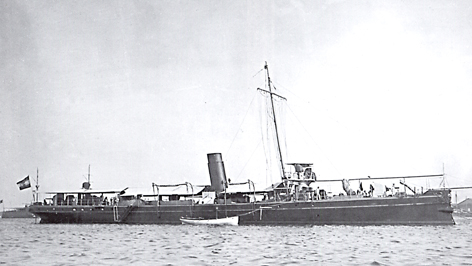
SMS Planet
Huszár class destroyers (1905)

Huszár – author’s illustration
The very first SMS Huszár (1905) was ordered from a British shipyard, Yarrow in London. She was lighter, yet more powerful than previous destroyers and therefore reached 28.2 knots with ease, well above the former ships. Indeed since the SMS meteor, power tripled. She was well armed with the same 45 cm torpedo tubes, seven 47mm QF guns as built, later changed to cal 30 guns and one 70 mm cal.45 gun. She was also ill-fated, running aground near Traste in the south adriatic on 3.12.1908 and sinking ten days later.
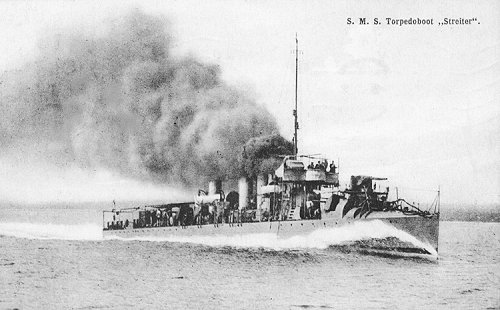
SMS Streiter
The Huszár class were among the most widespread of the fleet in 1914 by numbers. The prototype of this 13-units strong serie lost in 1908 was therefore replaced by a second of the same name in 1910. All were launched between 1905 and 1910 and some of their crews had relatively little training at the time of the opening of the conflict. They were in fact simple high seas torpedo boats with a greater range and tonnage, and this choice reflected the difficulty of the dual Monarchy to get out of the traditional pattern of a coastal defense navy. In 1913 their 47 mm guns were replaced by five modern high velocity, long range 66 mm guns. Apart from the Streiter, lost in a collision in March 1918, and the Wildfang who hit a mine in 1917, all survived the conflict and were handed over as reparations to Italy, France and Greece. The former hastened to scrap them in 1920.
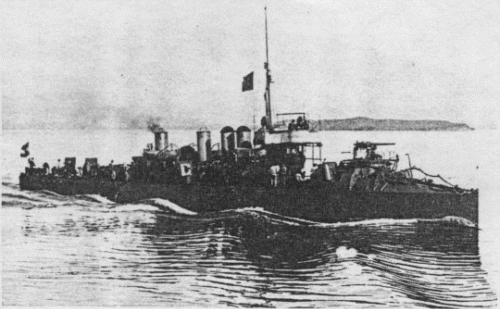
SMS Uhlan
Caracteristics:
Displacement: 390 tonnes
Dimensions: 68.4 x 6,3 x 1,9 0m
Propulsion: 4 Yarrow watertube boilers, 2 shafts, 3000 ihp. 28.5 Noeuds max.
Crew: 70
Armament: 1 x 66 mm, 7 x 47mm, 2 x 450 mm TTs.
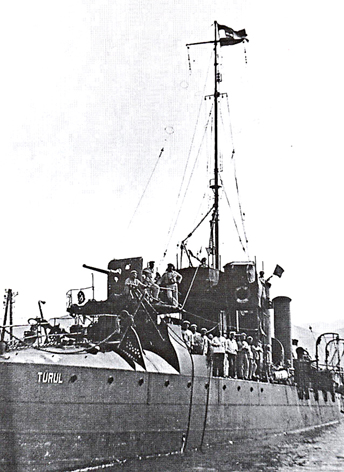
SMS Turul
SMS Warasdiner (1912)
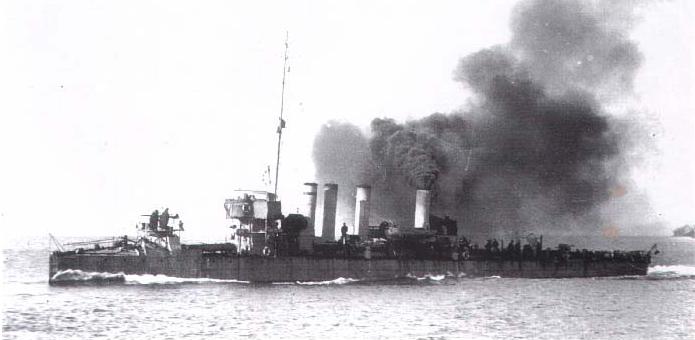
The single SMS warasdiner was virtually a repeat of the Huszár class built by STT for the Chinese Government, as Lung Tuan, first ordered in 1912. In fact she was intended to be the prototype of a class of 12 ships for the Chinese Navy. Due to the situation deteriorating fast, the ship, launched in August, 28, 1912, was taken over before delivery at the outbreak of war. She was renamed SMS warasdiner and taken in hands to be ported to Austrian standards, receiving her armament of two 66 mm (2.6 in) L/45 Skoda guns, four 6.6 cm L/30 guns, and the usual four 45 cm torpedo tubes. She saw service in the same way other destroyers of the related class, entering service on 10 September 1914. On 18–19 June 1915, she took part in a series of raids against towns on the Italian Adriatic coast. She shelled Monopoli (SE of Bari on 19 June), and on 5 December 1915while returning from another raid she spotted and sank the French submarine Fresnel, which had run aground off Cattaro. On 2 August 1916, Warasdiner and Wildfang shelled Molfetta but back home met the French destroyers Bisson and Commandant Bory, plus Italian destroyers Ardito and Impavido. They exchanged fire then set off in pursuit but broke off as they neared Cattaro defenses and the Austrian cruiser Aspern leaving the harbour for them. After the war she was given to Italy and scrapped in 1920.
Tátra class destroyers (1912)

In May 1910, the Admiralty ordered a new 800-ton destroyer design equipped with turbines capable of exceeding 32 knots. Blueprints were ordered to Danubius, CNT, STT and even Vulcan yards in Stettin. Finally, Danubius in Hungary was chosen to favor the Hungarian and therefore obtain support for the 1911 budget for the construction of the new dreadnoughts. Porto Ré (now Kraljevica), a construction site division, was entrusted with the six new ships. The Huszárs with their continuous low deck were little more than sea torpedo boats made for the Adriatic. The Tàtra changed the game with for the first time with a raised forecastle, significantly improving seaworthiness. These ships were likely to be able to intervene in all weathers and to have a much greater range of action. They were designed to reach and even exceed the contract speed of 32.5 knots and had mixed fuel coal/fuel boilers to save space. These powerplants turned 20,600 horsepower versus only 6000 on the Huszàr class, as a measure of progress in a span of a few years.
These ships (Tàtra, Balaton, Csepel, Luia, Triglav and Orjen) were launched in 1912-13, and had a very active life. Liua and Triglav were blown by mines off Durazzo, while the other four were assigned to Italy and continued to serve after the war as Fasana, Zenson, (scrapped in 1923), Muggia (lost in a storm in 1929) and Pola (renamed Zenson and deactivated in 1937). More details when the individual post on this class will be out.
Caracteristics
Displacement: 850 t standard, 1000 t FL
Dimensions: 83,5 x 7,8 x 3 m
Propulsion: 2 shafts, 2 AEG-Curtiss turbines, 6 boilers ( 2 coal/fuel burning ), 20 600 ihp. 32,6 knots.
Crew: 114
Armament: 2 x 100 mm, 6 x 66 mm, 1 x Skoda 8 mm MG, 4 x TLT 450 mm (2×2).
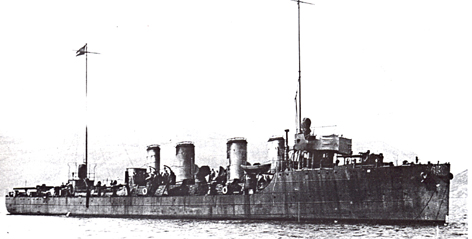
Ersatz Tátra class destroyers (1917)
The success of the Tàtra class did much for a new order at the same yard in 1914, for 6 new units, but the war interrupted this process and the order was brought back in 1916 to four units (Triglav, Lika, Dukla and Uzsok) in particular to replace the losses. These were authorized on 28 may 1914, for the 1914-15 naval budget. However they were never started due to the outbreak of the war, but the design was relaunched, following the need to replace losses and increase the number of destroyers available. The four units eventually completed, Triglav (iii), Lika (ii), Dukla and Uszok were launched repectively in February, May, July and September 1917 and completed in the fall of 1918. Because of this they saw little action.
These improved destrouers had a forecastle lengthened by two meters, slightly more engine power, and two 66 mm guns in dual purpose mounts. They were later attributed to Italy in 1920 (Grado, Cortellazo, Montfalcone, scrapped in 1937-39) and France (Matelot Leblanc, scrapped in 1936).
Caracteristics
Displacement: 880 t standard, 1045 t FL
Dimensions: 85,4 x 7,8 x 2.4 m
Propulsion: 2 shafts, 2 AEG-Curtiss turbines, 6 boilers (2 coal/fuel burning), 22 360 ihp. 32,6 knots.
Crew: 114
Armament: 2 x 100 mm, 6 x 66 mm/45, 1 Skoda 8 mm MG, 4 x TLT 450 mm (17.7in) (2×2).

Improved Tátra class destroyers (1918)
Four other 120 mm armed units were ordered on 22 December 1917, but never started due to the lack of steel. These rampant shortages were not the only ones and plagued the entire industrial effort of the Empire, due mostly to the genera allied blockade against central powers. Their specifications were the same as the previous Ersatz Tátra, to the excption of the powerplant, which were now Danubius turbines, and the armament, which now comprised not only brand new 120 mm/45 (4.7 in) guns but also two 90 mm/45 AA guns and the same pair of twin torpedo tubes banks.
Austro-Hungarian Destroyers in Action
The Austro-Hungarian side: 4 ships, total 6.050 tonnes and 33 guns, The enemy side: 13 ships, total 24.000 tonnes and 94 guns.
ATTACK AGAINST THE ITALIAN SHORE INSTALLATIONS
ON 24TH MAY 1915: The state of war with Italy started at midnight of 23rd May 1915, and in the same hour the all Austro-Hungarian Fleet has sailed out of ports and with them sailed the all des-
troyers of Tátra class. The task of destroyers Tátra and Csepel was to bomb port of Manfredonia. The night was very dark and the visibility reduced almost to nil because of the squalls. Suddenly a great shadow appeared in the night and a strong voice has asked the Csepel. „Chi siete voi? (Who are you?)” Lieutenant Pitamic at once replied „Sono io Indomito! (I am Indomito /an Italian destroyer/).” On board of Italian ship rang the telegraph and they left with the knowledge that they have met destroyer Indomito.
The small formation has arrived at Manfredonia Road at 04.15 hours. They have not found enemy ships in the port, but in the fog they could not identify exactly the shore military targets. In this time a rowing boat came to the destroyer and its master offered to sell them foods and fruits. Lieutenant-Commander Vukovič quickly asked the boatman where is the railway station, the signal station, where are the factories, and finally he said friendly to the boatman: “Now, it would be better to go away from here, because we will do a little bit bombing.” They have bombed for 45 minutes, and after completing their task, have sailed to the meeting point just before Vieste, where they had to join light cruiser Helgoland and destroyers Lika and Orjen.
The light cruiser Helgoland, which has bombed Barletta till 04.38 hours, has seen two approaching Italian destroyers. The light cruiser opened fire on them without delay, and one of the Italians turned to south-east and with her greater speed she could escape, while the other destroyer, the Turbine hurried for Vieste to get there some protection. The Helgoland has started to chase her. The Tátra and Csepel sailing also in direction of Vieste, at 05.10 hours have seen the destroyer sailing parallel with them. At first they have identified her as a friendly destroyer, but from the radio signal of Helgoland they have got the true information.
This radio signal was sent to the destroyers Lika and Orjen, which carried out their tasks also in the same area, so they have turned for the site of pursuing. SMS Tátra and Csepel opened fire at 05.45 and the Turbine responded immediately. The situation for the Italian destroyer has become hopeless, because the Austro-Hungarian warships have surrounded her from every side. Sub-lieutenant von Jordanis of SMS Lika has reported about this stage of the battle:
“I have opened fire with my battery from distance of 5200 m, and after several rounds we have bracketed the enemy. We were proceeding on a parallel course (with SMS Lika and the Italian Turbine) with 30 knots, while the Tátra and Csepel far away behind us were following the enemy ship. Now a shell 70-mm has hit the Turbine’s boiler room. Black smoke and steam has billowed up to the sky and the Italian destroyers lost her speed.”
Not long after SMS Tátra also had a score on deck of the enemy and a shell 100-mm has hit her engine room and destroyed her main engine. The Turbine slowed down and finally has stopped. Her captain, Lieutenant-Commander Bianchi, who has got a head wound, has made hoist the white flag. There were standing on her deck the officers and the crews blackened by the smoke and bloody rags and wounded men were laying everywhere. The Austro-Hungarian destroyers picked up 35 men, including her captain, and they have sent 10 shells into the waterline of Turbine while SMS Lika launched one torpedo into her side, and the Italian destroyer has sunk.
ATTACK AGAINST PORTO CORSINI, ON 24th OF MAY 1915
When the War with Italy has broken out, the Novara Group, as a part of the Fleet, has sailed from Pola on 23rd of May 1915 to be a participant of the general operation against the Italian coast. The Group consisted from the following units: light-cruiser Novara (Captain Miklós Horthy), destroyer Scharfschütze (Lieutenant-Commander Bogumil Nowotny), and torpedo boats 78 T (Lieutenant Johann Rössel), 79 T (Lieutenant Hans von Waldthurm), 80 T (Lieutenant Karl von Rastburg) and 81 T (Lieutenant Wolfgang Suppantschitsch). Their task was to carry out an attack against Porto Corsini, the outport of Ravenna. Next dawn at 03.00 hrs of 24th May, the destroyer Scharfschütze detached to enter into the canal, which had a 30 m width and a 1200 m length to destroy torpedo-boats, submarines and military establishments found there. The destroyer which had more than two times bigger length as the width of the canal, could not turn around after entering the canal’s entrance, so she entered backing by stern ahead, and after completing her task she could heading out from the canal in normal way. The captain of Scharfschütze has reported the following about the action:
„Even to enter the canal backing with full speed was not an easy task. I had not any description or sea maps and charts about the Canal and I did not know even the formation of the entrance. In the very little light (03.10) I have picked up with big luck the two light beacons of the entrance, of course without lights. The fairway from here was limited by two stone breakwater, which protruded 700 m from the flat coast to the sea.
Since I could not turn around in the Canal, I had to enter backing, stern ahead. After we have entered successfully between the breakwaters, two alarm shots was heard in the small town. I did not find nor torpedo boats, nor submarines in the Canal only two small sailing ships. (These I have destroyed by canon fire.) Before us on the Southern side of the Canal stood the two stories high dome of the signal station. I opened fire on it. This moment about 50 soldiers run toward us in skirmish-line from a far away barrack and we came under small arm fire from a trench. We have opened machinegun fire from 800 m on the attackers. A medium sized battery suddenly fired on us from the Northern side of the Canal. Trusting in our luck I have went on with slow speed. I mention a small inessential but characteristic event: an Italian Petty Officer has jumped out to the shore of the Canal and bellowed, „Cosa volete? (What do you want?) and after that an Italian shell struck the ground before him and he dropped on his knee.
For this time our immediate environment was liven up. The enemy sheltering behind the corners and ends of the small houses has opened a fierce fire on us. Although they were driven away from the shore, we were under fire of the invisible battery. One shell has grazed the radio mast, but most of them fell in the water around us or blew up on the Canal’s shore and threw a lot of sand on our ship. We came at the end of the Canal, where it is forking to Ravenna, but we did not see any enemy ship. At this moment we came under fire of another battery, so we sailed back to the sea with half speed. We were shooting a slow but very accurate fire from our after gun at the optical equipment of the signal station. Our fore gun and the side batteries were shooting at the trenches and several military facilities. We have arrived at 4.30 hrs to the Canal’s entrance and the open sea and rejoined light-cruiser Novara. The battle in the Canal went on 1 hour and 10 minutes. Our consumption of ammunition: 126 shell, 910 rounds of machinegun and rifle, and 50 rounds of revolver. The fire was ceased at 04.45. We had not any loss of personnel or material.” Thereafter the destroyer has sailed home with the torpedo boat 80 T.
ACTION AGAINST A TROOP CONVOY ON 31ST MAY 1916
The Fleet Headquarters has got news that an enemy troop convoy will sail through the Otranto-Strait on the end of May, so gave order to attack it. The destroyers Balaton, Orjen and torpedo boats 77 T, 79 T, 81 T have sailed at night of 31st May 1916 from Bay of Cattaro for action. They have arrived at the Otranto-Strait and searched in vain for the troop carriers. The news was not right or they have missed each other. Though off Saseno four trawlers were seen which were members of the Strait barrage forces. Orjen, the group leader sunk one of them with gunfire, thereupon the other three switched off their signal lights and released their towed antisubmarine nets. The trawlers have scattered and fled from the site but meantime radioed for help. The Austro-Hungarian units have received the radio signals. They were afraid of that the alarmed enemy forces might cut off their route to the base, so they have turned to home.
ATTACK AGAINST THE OTRANTO-STRAIT ANTISUBMARINE BARRAGE
ON 22nd DECEMBER 1916, the antisubmarine barrage of Otranto-Strait that consisted of trawlers’ nets combined with sea mines and explosive charges, made very difficult the breakthrough of the Central Powers’ submarines. That was the main reason that Austro-Hungarian Fleet carried out several attacks against the barrage. One of these actions was executed on 22nd December 1916 with
direct purpose to assist the return of German submarines U38 and U52 to the Adriatic Sea.
Four destroyers took part in the attack: Scharfschütze as leading ship, (Lieutenant-Commander Bogumil Nowotny), Dinara (Virgil Sándor Lieutenant-Commander), Réka (Lieutenant-Commander Milan von Milenkovich) and Velebit (Lieutenant-Commander Method Koch). The squadron has sailed from its station in the Bay of Cattaro at 12.00 hours on 22nd December 1916. At 18.00 hours they have considered to turn back because of the very heavy fog, but the wind suddenly blown away the fog and they continued their trip. At 20.00 hours they were at the Latitude of Saseno, where have turned toward Otranto-Strait. Réka, which stationed on the port wing of the formation, saw the first enemy ship at 21.18 hours. After several minutes the Scharfschütze also observed the two trawlers who made light signals and sent up signal rockets. The Force Commander turned toward them with his ship and the other three destroyers came in the wake of her. At 21.30 hours the Scharfschütze has opened fire and the Réka has followed her example. The trawlers left their towed nets and responded to the fire. One of them has finished the gunfight in very short time and started to sink, and after
several minutes the other trawler also sunk.
At this moment the Scharfschütze run forward and turned to north where other lights were seen. After several minutes the Réka overhauled her. This time they have observed new and very quickly approaching lights from North-Northwest. The two destroyers switched off their identification lights and slowed down that the two other destroyers may catch them. The Scharfschütze has recognised the enemy destroyers from their silhouettes and opened fire on them at 21.40 hours, which was responded immediately. The Velebit and Dinara were well behind of them in this time.
After a while the four approaching French destroyers, Protet, Commandant Bory, Dehorter and Boutefeu have changed their courses to eastward, and more two destroyers, the Casque and the Commandant Rivière arrived there. The Scharfschütze hit the Rivière at 21.48 hours and her shell has caused fire on the Frenchman board. The Casque went to assist her companion so the Scharfschütze and Réka have outrun them.
The French ships have tried to cut off the route of the Austro-Hungarian destroyers, while Lieutenant-Commander Nowotny wanted to breakthrough their line. The battle between the six French and the four Austro-Hungarian destroyers have started in a complete darkness, and in short time there was such a great chaos that nor the commanders of the groups, nor the captains of the individual ships could not review the situation.
The destroyers fought in close distance in the night, which was made darker by the occasion-ally switched on searchlights. They could not see the hits because of the smoke from the stacks and guns, so the captains could not make differences between the friendly and enemy units. Neither one of the participants nor could analyse wholly the course of battle in their own time, and they could clear the details only many years after the War. The French Admiral Forget, who then in rank of Lieutenant was captain of Protet and commander of the Second Destroyer Group, wrote this:
“We have seen lights at 21.30 hours and heard gunfire at 21.39 hours. Since I knew the character of our leader, Commander de Boisanger, I was afraid of that he would attack the en-
emy with full speed. In his flagship (Casque) and on board Rivière all boilers were operating with full capacity, but the other four destroyers have only ‘small fire’ in two boilers, and their
maximum speed was 19 knots. The Casque really has started with speed of 20 knots and at 21.46 hours she was forward with 600 meters. The Rivière left the formation and scampered after the flagship with speed of 28 knots. She has overhauled Casque when (21.48 hours) the flagship has got her in a heavy enemy fire. To avoid the overtaking, Rivière had to slow down and almost stopped. There was a great smoke because of this manoeuvre and we have lost sight of our both destroyers. I have turned to due east to cut off the route of the enemy supposedly retreating toward Cattaro and the other three destroyers followed me.”
After this let us see the report of Rivière:
“21.48 hours. Gunfire has flashed in a great arc before us made us blind. Have seen powerful searchlight beams and white lights, so we hauled up to the yard our identification signal R/B. It seemed so as if everybody were shooting us, and we have drew on ourselves not only the enemy fire but the trawlers’ also. (Note: The Rivière also opened fire on the trawlers from mistake, which have showed white lights.) At 21.52 hours we have seen two great smoke columns before us 42 degrees to port, and white lights on our starboard side. At 21.54 hours came a shout: Torpedo from starboard! And saw an enemy destroyer in distance of 100 meters, which immediately has opened fire on us. We turned away with full speed and the torpedo missed us. In this moment two hits exploded in our boiler room, our speed was reduced very quickly and we have left the battle site toward west.”
Lieutenant Forget has continued his report as follows:
“At 21.55 hours we have got ourselves in close combat, in which we could not make any differences between the enemy and friends, since both were firing on us. I knew that the Casque is somewhere in our neighbourhood so I have made switch on the identity signal on mast, but I have not got any response. The enemy sailed without any light. I smelt the coal gas (the French ships have burned oil), but I was afraid to use searchlight, for fearing to light one of our own units. From 22.15 hours I have pursued the enemy with full speed toward north, but could not find them.”
The report of destroyer Commandant Bory:
“The trawlers, which have pursued a submarine till this time, thought that we are an enemy unit, and attacked us. We have switched on our identity signals and turned to south after a suspicious target. Later on we have changed our course to north to rejoin destroyers Protet and Dehort.”
(Note: The French destroyers and Italian-British group that sailed from port also to pursue the enemy have meet each other only at 02.00 hours, but meantime the destroyers Abba with 31 knots has rammed first Casque and later Boutefeu. Bory had to take in tow the damaged Casque and the three damaged ships have arrived at Brindisi in the morning. The Abba lost one dead and one serious wounded in the collision.)
The Dinara and Velebit, which were fallen behind, have fought another battle for a while with the French destroyers who have attacked alternately them from port and starboard.
On board Dinara one sailor has died after a hit on the boiler room’s superstructure. The destroyer has turned to west in the action and after steaming only one hundred meters she could not find her group, so Lieutenant-Commander Sándor changed his course to north and steamed home alone.
After these actions the Velebit has overhauled her force and then started a new battle.
Lieutenant-Commander Nowotny, captain of Scharfschütze wrote the follows about this action in his report.
“We have seen the flashes of Réka guns when destroyer came out sometimes from the dense smoke behind us. At 21.45 hours shells hit the water on our port side and water flooded our deck. We have gained distance slowly and the enemy fire became weaker. At this moment we have observed that the four enemy destroyers well behind us crossed our line. Dinara has turned toward the nearest enemy (the Rivière) and the two destroyers have approached each other 100 meters. Dinara has launched 2 torpedoes, but the enemy avoided them skilfully, meanwhile the Dinara got five hits and has stopped. In this crucial moment the enemy has lost sight of us and in the great smoke we could slip through between the enemy destroyers and the trawlers who have emerged once again. We could see their light signals, but we have switched off the weak blue signal lights on our quarters. After a short time a searchlight came into life from 100 meters of Velebit and a torpedo was launched into the water but it missed the destroyer. The enemy then (at 22.05 hours) has tried to ram the Velebit, but the Hungarian gun layer Dudás placed sunglasses on the optical sight and destroyed the enemy searchlight with one shoot. The enemy destroyer has got more hits, so she steamed away in great hurry.”
After 22.22 hours the Scharfschütze Group reduced its speed to 20 knots and altered course first North-Northeast and at 22.55 to East. After several minutes they have seen the Casque who steamed from behind with an enormous speed in the beam of Velebit’s searchlight. The boiler room of the very fast Casque has got a hit, which destroyed two boilers, so the destroyer could not maintain the engagement because of the reduced speed. The Scharfschütze Group after this last engagement steamed home without any events. The Group has executed its task: saved the U38 from the antisubmarine nets of the trawlers and provided a free passage for the U52. The effects of the attack were so long, that on next day the U52 could pass the unguarded Otranto-Strait on the surface.
THE DESTROYER CSEPEL IN THE BATTLE OF OTRANTO-STRAIT
14 – 15TH MAY 1917: The details of the Battle of Otranto-Strait can be read in the history of light cruiser Novara. Here we are following the route of destroyer Csepel, who was one of the participants. Extract from the combat log of SMS Csepel: 14 – 15th May 1917.
Sailing in company of Balaton to the fairways. Speed to Menders: 20 knots. Course: 186,5°, Speed: 20 knots. 15th 05 01.27 To 14 sea miles to West from Saseno, Course: 141° 02.27 Course: 109,5 ° toward Mount Éliás, Patrol duty against enemy cargo ships to NW from Fano and attack cruisers on the trawlers’ route between Leuca and Fano. Date Time Position Actions – events Notes 02.31 About 800 m from Saseno, Course: 145° along the coastline. 15th 05 03.06 Course: 235°, Sped: 15 knots 03.10 Enemy in sight four points to port. 4 ships. 03.20 Steaming toward enemy. 03.24 11 see miles to
N from Fano. Identification of enemy: 1 Espero class destroyer and 3 cargo ships. Open fire on the enemy destroyer and destroying her with several accurate broadsides. Torpedo launching against 2 steamers. One of them got a hit under her bridge. According to the observation of several Petty Officers this cargo ship sunk in a short time. After that we have opened fire on the other steamers, who got fire. The destroyer is burning and sinking. 03.45 12 sea miles to N from Fano Ceased fire. Course: 320,5° Speed: 25 knots. 04.20 Gun flashes, supposedly from the cruisers. 04.45 14 sea miles to W from Saseno Course: 315°. 05.15 Course: 355° Speed: 20 knots. 07.35 Several smoke columns before us 4 point to port. 07.39 Changing course toward Dulcigno. Speed: 29 knots. The units in sight from starboard to port: 1 big destroyer, about 1.500 tonnes, nationality unknown /her silhouette similar as Quarto/, 4 destroyers Indomito class, 2 cruisers Liverpool class. The cruiser
Liverpool class gives several times the signal KCH, LCH with her searchlight. 08.12 Course toward Cape Rodoni. Enemy destroyers start the pursuing, trying to cut off our retreat to North, so
we are drawing them to Northeast. The cruisers are out of our sight.
08.15 Gunfight with enemy destroyers. Distance to enemy: 9000 – 12 000 meters. 08.32 One shell from our aft 10 cm gun hit the leading destroyer under her stack No 1, so she is turning out to
starboard from the column and stops with heavy smoke. The gun fights with the others destroyers are continuing. 08.52 Course to Cape Pali. The enemy changes its course and drops behind. Concentrate our fire to the pursuer Type Roman destroyer. The lighthouses of Valona and Saseno showing their lights in every hour. At the beginning the destroyer and the bigger steamer have responded with a weak gun fight.
09.00 To the signal Station Mali Durcit: “Open fire on the enemy units!” 09.05 Course toward Mali Durcit. The shore battery came into action with shellfire. The enemy turns to West. Cease-fire and we are stopping at the coast. 09.30 Cape Pali Altering course toward Menders, Speed: 12 knots 09.45 Speed: 20 knots. 10.57 10 sea miles to S of Dulcigno. Signal of Balaton: „Attack from enemy submarine” 2 torpedoes were launched against Balaton. Speed: 25 knots. 11.23 Menders Steaming on the prescribed route to Guirat. 12.00 Guirat Course: 275° to meet cruiser Sankt Georg. 12.26 Altering course toward Remo, Speed: 20 knots 13.06 Remo The Budapest + 3 torpedo boats are sailing. 13.45 Gjenovic Anchoring. At night cold weather, calm sea. At 08.30 hours comes fresh wind
from NE. Visibility is very good. Moon raised at 02.00, daytime visibility is also very good.
THE DESTROYER CSEPEL IN THE BATTLE OF OTRANTO-STRAIT
Memoir of Ottó Rauscher, formerly a quartermaster of Csepel: “We have been at anchor in the Bay of Cattaro on 14th May 1917, when about 6 p.m. we have got orders that the destroyers Csepel and Balaton must be ready to sail at 19.00 hours. The boilers of two destroyers were immediately stoked up and we have completed our supply of oil and fresh water. According to the scuttlebutt we would go far away to south, to the Otranto-Strait. At 19.00 hours we took in the mooring ropes fore and aft. The Csepel with both engines “slow ahead” followed the Balaton. We left the Bocche and steamed with three-quarter speed along the coastline. In a short time the night was falling and when we have passed Antivari (today Bar, Montenegro) the darkness closed about us. About midnight we have approached Durazzo (today Durres, Albania) what we could see since steamed close to the coasts. All went well, the Moon raised only about 02.00 hours, and the night was dark and the sea calm.
To avoid the beams of searchlights of Valona (today Vlora, Albania) we drew away from the coast toward Southwest. In the same time the three light cruisers, Novara, Helgoland and the Saida were in position already near to the eastern coast of Italy. After passing Valona we have turned once again toward the land and steamed slowly along the coast. We have arrived at our ambush position determined in the orders without sighting the enemy, and after that we had to do only our patrol with hope.
At 02.45 hours we have observed four thick lines on the western horizon. We have turned immediately toward them. Our destroyers approached quickly and they asked for our identity signal by Aldis lamp, finally lighted us with searchlight. In this moment Csepel opened fire with machineguns and in the same time gave also a broadside. The beam of the searchlight started to weak and finally died out. Now we have lighted her and observed a destroyer of the Nembo class, who was motionless because of a hit on her main steam pipeline.
Later on we have got information that she was the Borea and after a few minutes sunk. Immediately after this action we have torpedoed a cargo ship, which went also under the waves in a very short time. The Balaton opened fire on the other two steamers, which were shooting an intensive fire. Our two destroyers started to circulate around them and we have sent our broadsides from port and starboard to the cargo vessels. We were so near to them that we could hear impacts of our shells. The whole action took a half an hour. When we have left the site we could see the burning cargo vessels for a long time, which were towed to Valona in a seriously damaged state. One of the sunken vessels was the Caroccio (1.657 BRT), formerly the German steamer Choising, in which the landing party of German light cruiser Emden left on the Keeling Island made a part of its adventurous trip to home.
We had to meet our cruisers at 07.00 hours in a predetermined square. We cruised around this point without any result. Few minutes after 08.00 hour we have seen black smoke clouds toward Southwest, but they seemed doubtful. One intercepted enemy radio signal has confirmed that these smoke columns originated from bigger enemy warships. We had to turn immediately to our home port, since this British squadron has overpowered us very much in respect of guns. The enemy squadron consisted of the British light cruisers Bristol and Dartmouth and six Italian destroyers. The Italians have built these modern destroyers originally for Romania, but in 1915 were confiscated and commissioned to the Italian Fleet. I was on duty as a second boiler surveyor and I have sensed immediately the events. Actions stations were sounded and the engine-room telegraph moved to “full speed ahead” mark. So we had to open all the 12 jet nozzles, rev up to the maximum capacity the fuels pump, the
economiser pump and the ventilators. We steamed with full speed already half an hour, when the ship was shaken violently. The loud bang betrayed everything. Impact followed impact around us. Our two 10 cm guns returned the fire. When an enemy shell hit the water near to us, our ship was lifted a little. After a while the gunfire was weakened, then once again became very intensive. The explosions of shells fallen around us were so intense that I thought we got some hits. To put it concisely the hell was broken loose. The intensity of fight raised, when I heard cheering from deck through the ventilator’ shaft. What happened? The noise of battle reduced a little bit and the guns slowly were silenced. Though the silent period was not long, because after a short time two single shots shook the ship and once again came a pause.
In the following silent we steamed yet with full speed and the ship has shivered in her every joints. The temperature of boiler room went up to 64°C but was not unbearable. Then the gunfire started once again. Explosion came after explosion and I have believed that those are hits. I have lost my time sense. When the silent came we steamed with only half speed. I have opened the entering hatch and saw the coastline to starboard in some distance. My first thought was where are we? I breathed the cool air and sweat started flow dawn in small streams on my chest. In the dry air of the boiler room the sweat evaporated immediately. For the same reason I did not feel thirst, but now the sudden change of temperature caused a terrible thirst.
I have seen sporadic gunfire before us on the coast, when a stoker came to me with a jug of vine and a glass in his hands. He told me that according to the captain’s order we must reinforce ourselves. I have asked two questions. Where we are? What happened?
The follows were unravelled: When we have seen the smoke clouds at 08.00 hours toward Southwest and got news from the radio message about the approaching enemy, we took course toward Cattaro laid 130 sea miles from us. The enemy arrived from Southwest and tried to cut off our route to northward. After a long pursuing we were in the range of their bigger guns, but they have stayed out of our 10-cm guns’ range. Still we have responded fire and achieved a direct hit on the leading destroyer that has stopped in a great smoke cloud. She was in the way of her own squadron so they had to turn to port to avoid her, but even we could not keep them from overhauling us. Our captain felt the danger and changed course toward Durazzo and so the enemy was left behind. This was the reason of the short pause in the gunfire that was restarted when a new target was seen on our starboard quarter and we thought that she is an enemy torpedo boat. We will not know never what was it because the Italian torpedo boats have not participated in the action. After the enemy has turned away we steamed 2 The landing party of Emden have transferred from the small sailing ship Ayesha to the Choising just off Holland-East-India. The Choising has crossed the Indian-Ocean and steamed into the Red-Sea, where the German party has landed at Hodeida on 8th January 1915. The ship on 12th January went over to the other side of the Red Sea to Massawa, since Italy was yet neutral in that time. When Italy has entered into the War, the ship was confiscated and got a new Italian name, Caroccio.
with half speed toward our homeport along the coastline. When we have left the Bay of San Giovanni di Medua we increased our speed up to 25 knots because of submarine danger. Actually we have got a long distance torpedo attack from starboard. The torpedoes have run between the Balaton and Csepel toward the open sea. We have turned toward the sea just before 12.00 hours, since armoured cruiser Sankt Georg sailed from Cattaro and we had to assist to the torpedo boat flotilla. At 13.00 hours we have got a report that the enemy forces fighting with our light cruisers have retreated, so after that we have got order to return to our base.
The destroyers, after the torpedo boats, were the busiest units during the war. They were employed as working horses of the fleet. Their basic tasks were the escorting and supporting the bigger warships, but beyond that they have participated in countless independent action, patrol and reconnaissance and escorted vessels and convoys carried supplies, soldiers and wounded. Naturally it was not possible to mention their all actions because of the reason extensional and the limits of the sources in hand, but from the above text everybody can see that their crew and officers did well their duties. The fates of Austro-Hungarian destroyers approve the high quality work of the Austrian and Hungarian shipyards, since several destroyers after the very hard wartime duty have remained in commission for a long time in the fleets of victorious Powers.
THE FATE OF DESTROYERS DURING AND AFTER THE WAR
HUSZÁR (I) Run aground in a storm on 3rd December 1908 off Traste and sunk.
WILDFANG Run on a mine on 4th June 1917 on the North-Adriatic-Sea to west from Peneda and sunk.
STREITER On 16th April 1918 near to Laurana she has collided with steamer Petka which was in the convoy escorted by her, and sunk.
TRIGLAV (I) Run on an Italian mine before Durazzo on 29th December 1915, but was taken into tow and later near to Cap Rodoni was scuttled.
LIKA (I) Run on an Italian mine before Durazzo on 29th December 1915 and sunk.
Destroyers allowed by the Peace-Treaty of 1920 to Italy and commissioned in the Italian Fleet:
TÁTRA Served as FASANA. In 1923 deleted from the Navy’s List and was broken up.
BALATON Served as ZENSON. In 1923 deleted from the Navy’s List and was broken up.
CSEPEL Served as MUGGIA. On 25th March 1929 sunk in a typhoon near to Chinese Amoy.
ORJEN Served as POLA, in 1931 renamed ZENSON. Deleted from the Navy’s List in 1937.
UZSOK Served as MONFALCONE. Deleted from the Navy’s List in 1939.
LIKA II. Served as CORTELAZZO. Deleted from the Navy’s List in 1939.
TRIGLAV II. Served as GRADO. Deleted from the Navy’s List in 1939.
Destroyers allowed to Italy and were broken up there by the Italians
WARASDINER, SCHARFSCHÜTZE, CSIKÓS, USKOKE, VELEBIT, HUSZÁR II, TURUL, DINARA
Destroyers allowed by the Peace-Treaty of 1920 to France and commissioned
in the French Fleet:
DUKLA Served as MATELOT LEBLANC. Deleted from the Navy’s List in 1935.
Destroyers allowed to France and were broken up there by the French; RÉKA, PANDÚR.
Destroyer allowed by the Peace-Treaty of 1920 to Greece and commissioned in the Greek Fleet:
ULAN Served as SMYRNI. Was broken up in 1932.
Sources Read More
https://web.archive.org/web/20160309152239/http://mateinfo.hu/destroyer-actions.pdf
https://en.wikipedia.org/wiki/Husz%C3%A1r-class_destroyer
https://en.wikipedia.org/wiki/List_of_ships_of_the_Austro-Hungarian_Navy
https://en.wikipedia.org/wiki/SMS_Warasdiner
http://ejournal6.com/journals_n/1394803254.pdf
http://www.naval-history.net/WW1NavyAustrian.htm
http://mateinfo.hu/destroyers.pdf
https://portal.dnb.de/opac/mvb/cover.htm?isbn=978-3-7450-4226-9
http://www.kriegsmarine.at/
http://www.kuk-kriegsmarine.at/
https://de.wikipedia.org/wiki/SMS_Magnet
https://de.wikipedia.org/wiki/Meteor-Klasse_(1887)
https://de.wikipedia.org/wiki/Husz%C3%A1r-Klasse
https://en.wikipedia.org/wiki/Husz%C3%A1r-class_destroyer
ALMANACH für die k.u.k. KRIEGSMARINE 1905, 1909, 1913, 1917
Dr. Bak József, Dr. Csonkaréti Károly, Lévay Gábor, Sárhidai Gyula: HADIHAJÓK, Zrínyi Katonai Kiadó, Budapest, 1984
Csonkaréti Károly: HORTHY a tengerész: Zrínyi kiadó, Budapest 1993.
Csonkaréti Károly: Az OSZTRÁK-MAGYAR MONARCHIA HADITENGERÉSZETE, Kossuth Kiadó, Budapest 2001.
Dr. Csonkaréti Károly: CSÁSZÁRI ÉS KIRÁLYI HADIHAJÓK, Hajja és Fiai, Debrecen, 2002.
Greger, René: AUSTRO-HUNGARIAN WARSHIPS OF WORLD WAR I., Ian Allan Ltd. London.
Kertész Róbert: HAJÓK ÉS HŐSÖK, Franklin Társulat, Budapest, évszám nélkül Marine, Gestern-Heute: Several copies, Mistelbach, Ausztria.
Martiny, Nikolaus: BILDDOKUMENTE AUS ÖSTERREICH-UNGARNS SEEKRIEG 1914-1918. I-II. Leytam – Verlag, Graz, 1939.
Sokol, Hugo Hans: ÖSTERREICH-UNGARNS SEEKRIEG 1914-1918. Amalthea, Zürich-Leipuig-Wien, 1935.
Sokol, A.E.: SEEMACHT ÖSTERREICH, Die Kaiserliche und Königliche Kriegsmarine, 1382-1918. Verlag Fritz Molden, Wien-München- Zürich, 1972.

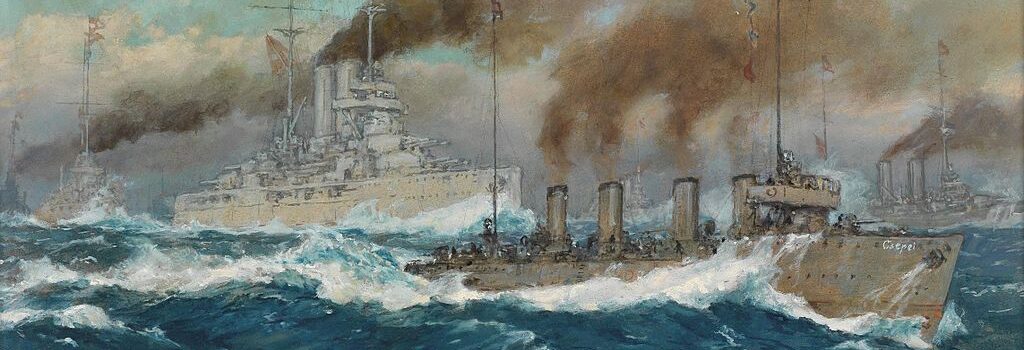

 Latest Facebook Entry -
Latest Facebook Entry -  X(Tweeter) Naval Encyclopedia's deck archive
X(Tweeter) Naval Encyclopedia's deck archive Instagram (@navalencyc)
Instagram (@navalencyc)





 French Navy
French Navy Royal Navy
Royal Navy Russian Navy
Russian Navy Armada Espanola
Armada Espanola Austrian Navy
Austrian Navy K.u.K. Kriegsmarine
K.u.K. Kriegsmarine Dansk Marine
Dansk Marine Nautiko Hellenon
Nautiko Hellenon Koninklije Marine 1870
Koninklije Marine 1870 Marinha do Brasil
Marinha do Brasil Osmanlı Donanması
Osmanlı Donanması Marina Do Peru
Marina Do Peru Marinha do Portugal
Marinha do Portugal Regia Marina 1870
Regia Marina 1870 Nihhon Kaigun 1870
Nihhon Kaigun 1870 Preußische Marine 1870
Preußische Marine 1870 Russkiy Flot 1870
Russkiy Flot 1870 Svenska marinen
Svenska marinen Søværnet
Søværnet Union Navy
Union Navy Confederate Navy
Confederate Navy Armada de Argentina
Armada de Argentina Imperial Chinese Navy
Imperial Chinese Navy Marinha do Portugal
Marinha do Portugal Mexico
Mexico Kaiserliche Marine
Kaiserliche Marine 1898 US Navy
1898 US Navy Sovietskiy Flot
Sovietskiy Flot Royal Canadian Navy
Royal Canadian Navy Royal Australian Navy
Royal Australian Navy RNZN Fleet
RNZN Fleet Chinese Navy 1937
Chinese Navy 1937 Kriegsmarine
Kriegsmarine Chilean Navy
Chilean Navy Danish Navy
Danish Navy Finnish Navy
Finnish Navy Hellenic Navy
Hellenic Navy Polish Navy
Polish Navy Romanian Navy
Romanian Navy Turkish Navy
Turkish Navy Royal Yugoslav Navy
Royal Yugoslav Navy Royal Thai Navy
Royal Thai Navy Minor Navies
Minor Navies Albania
Albania Austria
Austria Belgium
Belgium Columbia
Columbia Costa Rica
Costa Rica Cuba
Cuba Czechoslovakia
Czechoslovakia Dominican Republic
Dominican Republic Haiti
Haiti Hungary
Hungary Honduras
Honduras Estonia
Estonia Iceland
Iceland Eire
Eire Equador
Equador Iran
Iran Iraq
Iraq Latvia
Latvia Liberia
Liberia Lithuania
Lithuania Mandchukuo
Mandchukuo Morocco
Morocco Nicaragua
Nicaragua Persia
Persia San Salvador
San Salvador Sarawak
Sarawak Uruguay
Uruguay Venezuela
Venezuela Zanzibar
Zanzibar Warsaw Pact Navies
Warsaw Pact Navies Bulgaria
Bulgaria Hungary
Hungary

 Bundesmarine
Bundesmarine Dutch Navy
Dutch Navy Hellenic Navy
Hellenic Navy Marina Militare
Marina Militare Yugoslav Navy
Yugoslav Navy Chinese Navy
Chinese Navy Indian Navy
Indian Navy Indonesian Navy
Indonesian Navy JMSDF
JMSDF North Korean Navy
North Korean Navy Pakistani Navy
Pakistani Navy Philippines Navy
Philippines Navy ROKN
ROKN Rep. of Singapore Navy
Rep. of Singapore Navy Taiwanese Navy
Taiwanese Navy IDF Navy
IDF Navy Saudi Navy
Saudi Navy Royal New Zealand Navy
Royal New Zealand Navy Egyptian Navy
Egyptian Navy South African Navy
South African Navy






























 Ukrainian Navy
Ukrainian Navy dbodesign
dbodesign